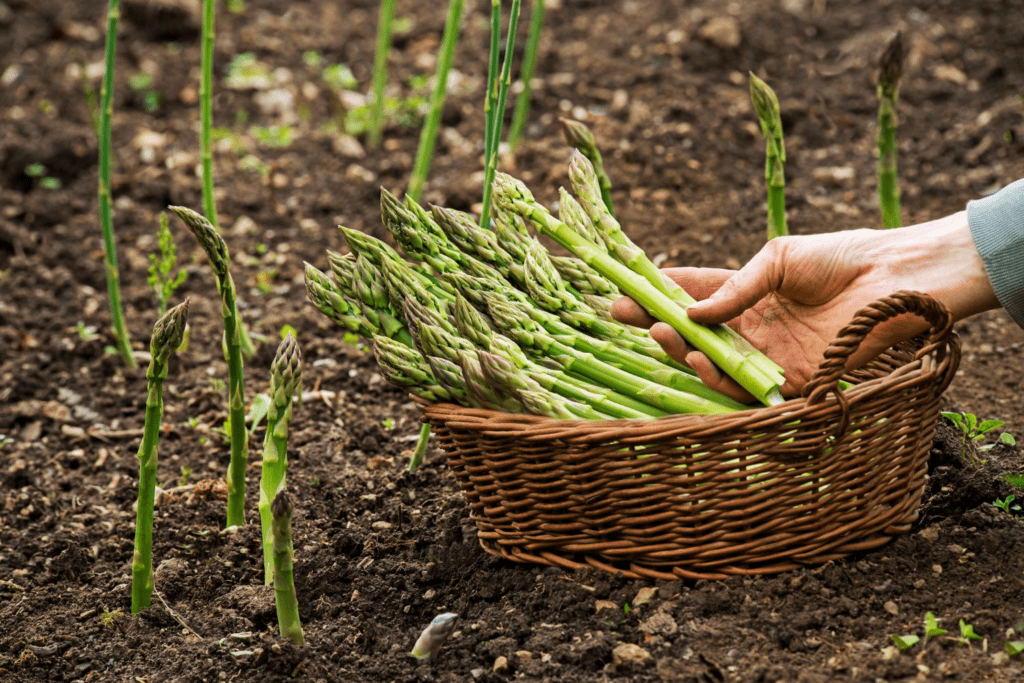Growing Asparagus in Pots – How to Grow and Care for Asparagus?
Hey folks! Welcome back!
I hope you are doing great in your gardening field. Do you know about the asparagus plants? Are you worrying about Growing Asparagus in pots? Yes, that can be done! Asparagus is a vegetable that is full of nutrients that can help boost energy, cleanse the waste disposal system of the body, and have many other benefits.
This vegetable has many benefits thus it has become one of the best plants to be grown at home. In this article, we are going to shed some light on growing Asparagus in pots along with a few growth and care tips.
Key takeaways:
- Asparagus is an easy plant to grow and maintain, which is a perennial to be savoured all around the year.
- Just planting the seed and taking care for a year, this plant can be savoured for about 20-25 more years.
- This plant is a significant investment once planted, and one can gain various returns which are healthy and good for the gut.

| Common Name | Asparagus |
| Botanical Name | Asparagus officinalis |
| Family | Asparagaceae |
| Plant Type | Perennial, vegetable |
| Mature Size | 4 ft. tall, 2 ft. wide |
| Sun Exposure | Full sun |
| Soil Type | Sandy, loamy |
| Soil pH | Neutral, acidic |
| Bloom Time | Summer, fall |
| Flower Color | Yellow, green |
| Hardiness Zones | 3-10 (USDA) |
| Native Area | Europe, Africa |
| Toxicity | Berries toxic to humans |
What is an Asparagus plant?
Asparagus is one of the plants that is a perennial, vegetable plant that can be easily grown in your home garden. It will grow tall in your area. It belongs to the Lily family. It produces feathery foliage in the plant that is called Fronds.
Its shoots are edible and its roots are amazing and they are known as crowns. It is easy to grow plants, but all you need is to maintain the growth of the plant by following the caring routine that is mentioned in the guide. It is easy to grow plants, but all you need is to maintain the growth of the plant by following the caring mention in the sky.
About growing Asparagus in pots
Asparagus is a tasty vegetable that is usually grown in soil beds, nurseries, or gardens. It is a nutrient-packed vegetable that is a type of succulent. One can plant seeds of this plant in or around spring, and the seeds can take two to three weeks to germinate.
February to June is the peak season to enjoy this amazing vegetable. There are many ways to eat Asparagus, hot, cold, raw, or cooked. This vegetable can be used in main dishes or even as salads in side dishes.
Usually, Asparagus is planted on grounds in soil beds outside, but those who do not have a garden can also enjoy this amazing vegetable by growing Asparagus in pots.
Growing Asparagus in pots
Asparagus thrives in rich and moist soil, with ample space and proper sunlight. But everyone who does not have a garden space can also get benefits by growing Asparagus in pots.
Those people who are opting for the option of growing Asparagus in pots need to take care of certain considerations :
- Asparagus plant, when entirely grown from seeds can take up to 3 years to be established.
- During the growth of the plant or the establishment period of the plant, it should not be harvested at all.
- While growing Asparagus in pots from seeds, the waiting period is very long, thus many people prefer to buy it directly from farmers or stores or do not plant the seeds, instead they plant the crowns.

- Crowns are the plants that have been already cultivated for 2 or more years by farmers or nurseries.
- Growing Asparagus in pots through crowns can decrease the waiting period and increase the savoring period as these plants grow continuously once harvested for 20 or more years.
- Growing Asparagus in pots is a space-saving technique though it might decrease the plant’s life compared to growing it outside in soil beds with ample space.
- Growing Asparagus in pots might directly cut the savoring time to half or even less as growing Asparagus in pots might not be healthy for the plant’s health.
Growing Asparagus in pots– Way of Growing Asparagus in pots!
Pot or container description:
Growing Asparagus in pots might require some time, containers, and patience. Each crown should separately be planted in a container or a pot that is at least 18-20 inches deep and 12-15 inches wide.
Spring is the best time for Growing Asparagus in pots or otherwise.
The pots or containers should contain proper drainage holes. Almost all containers or pots do have drain holes, but a few additional holes can help the plant, or many gardeners do the same at least. But if you are not a professional gardener not to worry, the containers or pots with already drilled drainage holes can be directly used.
About Potting the Plant:
Start by filling the bottom-most part of the plant around 2-2.5 inches with gravel. After that fill the entire pot with a mixture of good quality potting soil and compost, leaving half an inch from the rim of the pot or the container.
After soil filling, plant the Asparagus crowns as instructed by the gardener or personnel from the nursery. If not, then you can plant the crowns about 5-6 inches deep in the pot.
Watering the plant:
Watering the plant well is beneficial as this plant requires a good amount of watering.

Placement of the Pot:
Full sun is most suitable for this plant. Choosing a sunny spot with ample sunlight or at least 8-10 hours of sunlight a day is a must.
For more such plant related-articles, you may also read, Vegetables for Autumn Harvest – Vegetables to Grow in Winter
How to Care for Asparagus in pots?
Following are the caring tips for Asparagus in pots. They are as follows:
Sunlight
- This plant requires a good amount of full sunlight for its growth.
- If it does not receive a good amount of sunlight, then you will observe that the plant is growing slowly and is becoming weak.
- It will be more prone to diseases.
Soil
- You need to improve the texture of your soil to grow a healthy asparagus plant.
- The pH level for this plant lies between 6.5 to 7.0 range which should be slightly neutral.
- Soil should be rich in organic matter and should drain quickly.
Water
- Water is required by every plant. The same is the case with this plant.
- It requires water regularly especially when the plant is in its growing zone.
- You have to provide them with one to 2 inches of water every week so that they grow well.
- When the plan becomes mature, you can switch the frequency of watering to 1 inch per week.
Fertilizer
- This plant requires a good amount of fertilizer that should be rich in compost.
- You can make use of all-purpose organic fertilizer for your plant.
- By providing nutrients to the plant, you are helping them to grow a strong root system in the plant.
- You have to fertilize the plant at the arrival of the spring spring season before the shoot appears.
- Being a heavy feeder, you can provide it with a good amount of fertilizer, even in the middle of the spring.

Common Pests and Diseases in Asparagus
Below are the common pests and diseases in asparagus. They are as follows:
Purple Spot
- It is one of the problems faced by this plant.
- It will form oval-shaped purple spots on the spears which shows that the plant is infected.
- It is one of the fungal infections caused in the plant by the splashes of rain.
- you have to provide good circulation of air in the plant so that the plant feels free to grow.
- Also, you can make use of fungi spray to remove this issue.
Rust
- Rust is one of the common problems that is faced by every plant and the same is the case with this plant. It is a foliar disease.
- You have to provide good spacing to your plant to prevent rust in the plant.
- You can try to plant those cultivars that are disease-resistant.
- If you see this issue at the earliest stage, then you can make use of fungicides to cure this issue.
Fusarium Crown And Root Rot
- Another problem that is being faced by the asparagus plant is the root rot in the plant.
- You have to protect your plant from being infected by the root rot by choosing those cultivars that are disease-resistant.
Asparagus Miners
- You will observe asparagus miners in the plant that are tiny but will damage the plant along with its stem.
- So you have to remove them voluntarily as they will damage your whole plant.
- You can make use of Neem oil by spraying it on the leaves as it is an organic treatment for the plant.
Asparagus Beetles
- Some of the asparagus beetles will come to the plant to chew the ferns.
- So you have to prevent them so that you protect your plant.
- First, you have to check if they are destroying the plant, especially in the afternoon.
- After that, you have to make use of organic oil such as neem oil, so that you get rid of the asparagus beetles from your plant.
When to Harvest Potted Asparagus?
You need to know when to harvest, the spotted asparagus plants in your garden. So below are the tips to follow to know when to harvest it. They are as follows:
- You have to keep in mind not to harvest this plant in the first year after you plant this variety.
- It will help the plant to grow more and become fully established.
- And in the second year, you can harvest this plant in a few weeks.
- Then the arrival of the third year invites you to harvest plants for 6 to 8 weeks.
- Last, but not least, after harvesting the plant, you have to keep in mind that the plant will grow in the growing season.
So, in the following year, the plant will produce more spears in the plant.

Tips for Growing Asparagus in pots
- After growing Asparagus in pots from crowns, shoots might appear within a week or two.
- Allowing the plants to establish for the first two bloom seasons can be helpful in plant health and growth span.
- Weeds are the biggest destroyer of this plant so mulching around the plant will ensure good plant health.
- You can leave the plant outside on the balcony or in window spaces during all seasons as these plants are hardy.
Why does Asparagus take so long to grow?
Are you worrying about the long process of growing of asparagus plant? if yes, then you should not as after harvesting this plant, the plant develops more strongly. It is because it cut down the whole plant at the time of harvesting. So in the second year, you will notice that the shoots begin to emerge in the plant and become mature.
I know it is a long period but you have to wait to enjoy the benefits of this plant. More of the gardeners will purchase the plant from the market. In the form of crowns that are already grown 2-3 years at a farm. But you can choose this method if you want to do so as it will reduce your waiting period between the harvesting and the planting.
Wrapping up the context
In this guide, you come to know that Asparagus is one of the plants that is a perennial, vegetable plant that can be easily grown in your home garden. It will grow tall in your area. It belongs to the Lily family. It produces feathery foliage in the plant that is called Fronds.
Its shoots are edible and its roots are amazing and they are known as crowns. It is easy to grow plants, but all you need is to maintain the growth of the plant by following the caring routine that is mentioned in the guide. It is easy to grow plants, but all you need is to maintain the growth of the plant by following the caring mention in the sky. I hope you understand this guide well.
Thanks for reading! Happy Gardening!
FAQs
Is Asparagus a fruit or a vegetable?
Asparagus is a vegetable that is packed with nutrients. This plant is a significant investment once planted, and one can gain various returns which are healthy and good for the gut.
Does Asparagus grow well in pots or containers?
While growing Asparagus in pots from seeds, the waiting period is very long, thus many people prefer to buy it directly from farmers or stores or do not plant the seeds, instead, they plant the crowns.
Growing Asparagus in pots through crowns can decrease the waiting period and increases the savoring period as these plants grow continuously once harvested for 20 or more years. Growing Asparagus in pots is a space-saving technique though it might decrease the plant’s life compared to growing it outside in soil beds with ample space.
Does Asparagus need full or partial sun?
Full sun is most suitable for this plant. Choosing a sunny spot with ample sunlight or at least 8-10 hours of sunlight a day is a must.


